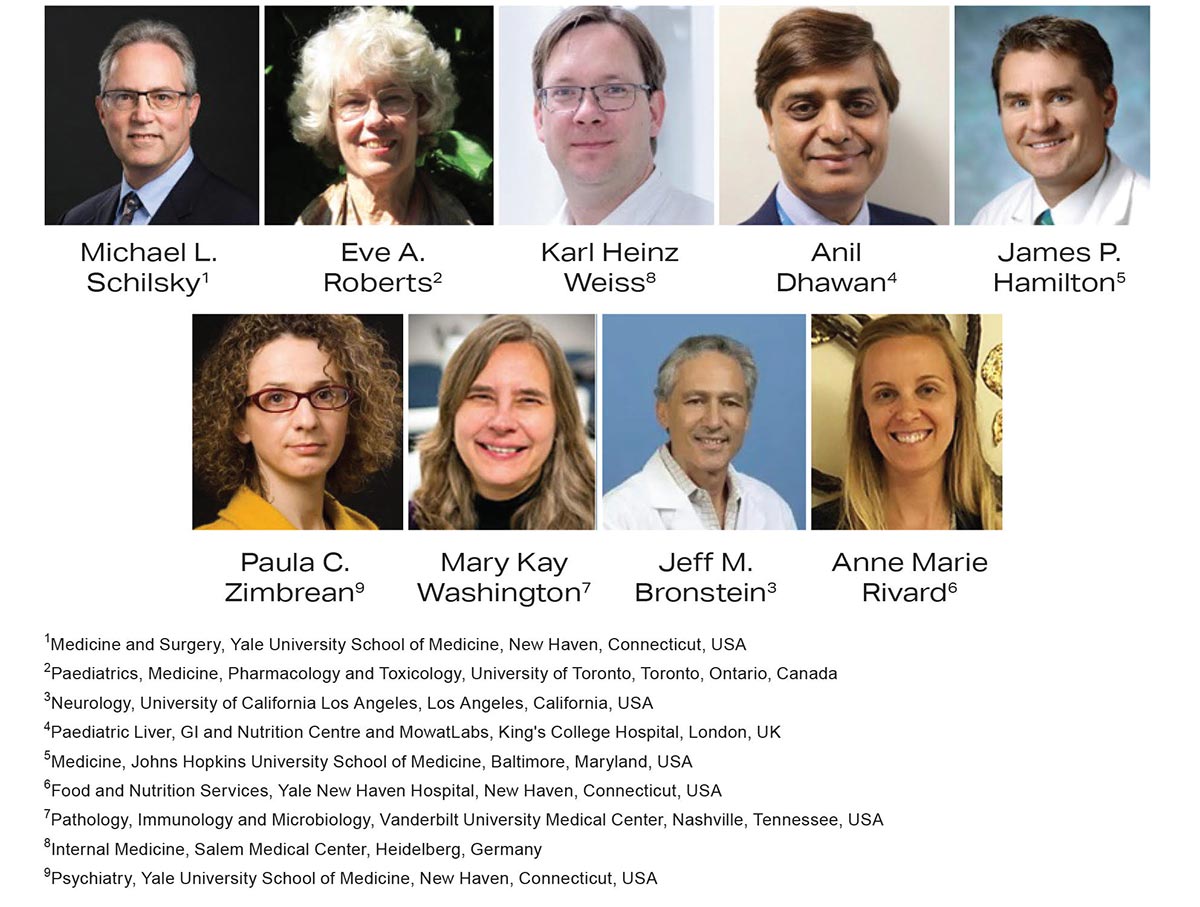Recent Posts
THE STORY OF MY WILSON DISEASE: AGE 8 TO 53
By Barbara Noci I was born on the 6th of April 1972 in Empoli, a little city near Florence in [...]
Travis’s Story of Wilson Disease
Rare and Rural By Rhonda Rowland, WDA President We all love a small town. Images come to mind of holiday [...]
Newborn Screening for Wilson Disease
A 25-year dream coming close to reality By Alice Williams, WDA Communications Director Since the 1960s, the United States has [...]
Can Copper be Absorbed Through the Skin?
By Edward Tabor, MD, WDA Board Member The main source of copper for humans is food, and Wilson disease patients [...]
They Said “Yes” to Gene Therapy
By Rhonda Rowland, WDA PresidentWe continue the story of two trailblazers who are among the first Wilson disease (WD) patients [...]
Meet the Inaugural Gene Therapy Candidates
By Rhonda Rowland, WDA President The two gene therapy clinical trials for Wilson disease (WD) launched by Ultragenyx and [...]
A New Guidance on Wilson Disease
Diagnosis|Treatment|Monitoring
By Rhonda Rowland

Let’s be clear on definitions. We’re talking about a guidance, not a guideline. There’s a difference? In medicine, there is.
Guidelines are meant to ensure that patients get the most up-to-date treatment and care. Doctors develop them by carefully culling through available medical literature, and based on their findings — which involve a lot of statistics — giving specific recommendations for other doctors to follow.
A guidance is also meant to ensure good care. But it’s put together differently. When it comes to rare diseases, there’s typically a shortage of studies that include a large number of patients for doctors to evaluate. So, a guidance provides the added bonus of expert opinion.
“In the area of rare disease, and in Wilson disease in particular, we have to include the limited evidence base, and try to build on those shoulders with experience,” explained Dr. Michael Schilsky, who directs the WD Center of Excellence at Yale University.
Dr. Schilsky and Dr. Eve Roberts are co-first authors of the new guidance.
“I’m much more comfortable today writing a guidance for a rare disease, rather than a guideline,” said Dr. Eve Roberts, who was part of the Toronto team that discovered the ATP7B gene for WD. “The question for a rare disease is often not ‘what do we do?’ But, ‘does this ever happen?’ A doctor may say ‘I have this weird case, I think it’s Wilson disease, but it doesn’t look quite like textbook Wilson disease.’ The guidance should be able to give them some insight into just the simple question of ‘Is this a possibility?’ ‘Has this been seen?’”
Doctors must look for Wilson disease in order to make the diagnosis. The guidance’s additional insight from expert experience may mean fewer missed cases and a faster diagnosis for patients.
“Perhaps the whole point of the guidance is to accept that not all diseases fit into a statistical approach quite so well,” added Dr. Roberts.
Why is this Guidance important?
It’s the first updated communication published by the American Association for the Study of Liver Diseases (AASLD) since Drs. Roberts and Schilsky published the first Guidelines for WD in 2003, and then updated them in 2008. Both doctors are liver specialists.
“Things really did change to a large degree,” said Dr. Schilsky. “Some things stay constant and other things have evolved in terms of our practice, our thinking, our approach.”
And, this time around, Drs. Schilsky and Roberts made yet another innovation. They invited a team of other specialists, who are experienced in some aspect of WD, to join them.
“The first innovative thing was that this was a guidance, and not a guideline, and the second was the idea of a multidisciplinary group,” said Dr. Roberts. “We were saying that putting the hepatologist on the highest pedestal is not going to work.”
That could be a hard sell to a preeminent liver organization like the AASLD.
“It’s a recognition that Wilson disease does cross those boundaries outside the liver and requires that larger look,” said Dr. Schilsky. “We had to show our colleagues that putting this village together was not going to dilute the ability to focus on the basic tenets of diagnosis, treatment and monitoring.”
The village they gathered was an international group that included not only pediatric and adult liver experts, a pathologist and copper expert, but a neurologist, psychiatrist and dietitian.

“These are all truly leaders in their disciplines, so we didn’t have a hard sell,” said Dr. Schilsky. The team also wanted the guidance to be practical and useful. “This is one-stop shopping when it comes to use.”
That translates into better patient care.
Diagnosis
“In the diagnostic phase, which I think is the most challenging, we put forth three algorithms,” explained Dr. Schilsky. “One for those presenting with liver disease, neurologic disease and then screening families of diagnosed patients.”
In order to catch the patients who may not fit neatly into one of the algorithms, Dr. Roberts had another new idea, and that was to include a checklist for “gray areas.”
“As far as I know, this is very innovative,” said Dr. Roberts. “The ‘gray areas’ table is to help you structure your thinking so you had clues from the committee as to the things to consider when you’re trying to sort out a ‘gray area’ problem.”
Treatment
Once the diagnosis of WD is made, the next step is treatment. Where does a doctor start?
“One of our enhancements in the guidance was to step back and think about treatment in terms of where people are in the disease phase, so it’s not a one-size-fits-all,” said Dr. Schilsky. “If you’re starting at the beginning, versus starting with a patient that you’re trying to rescue from liver failure, you might take a different approach.”
There are specific treatment recommendations for when a patient is first diagnosed, the maintenance phase of the disease, what overtreatment might look like and what might be treatment failure.
Monitoring
It’s not a secret in medicine that when a patient appears to be “bad” and non-compliant with their treatment, and doesn’t follow the care plans their doctor recommends, it hurts the doctor-patient relationship. In fact, it’s so strong that there’s actually a stigma associated with it. But, in Wilson disease, what may appear to be non-adherence, may not be. And, what might be a sign of treatment failure soon after diagnosis may look different later in a patient’s WD journey.
“It’s a really important point because most people think that if there’s treatment failure, the options are, it was never going to work in the first place, or it’s a non-compliant patient who doesn’t want to take medication properly,” explained Dr. Roberts. “But there are other options, and it’s important to open the discussion beyond the obvious stuff.”
The new guidance gives a pathway for doctors to consider other possibilities.
“Maybe the person went to Mexico and has gotten hepatitis A, it could be some other problem quite apart from non-adherence,” said Dr. Roberts.
And, it gives guideposts in monitoring patients to catch treatment failure before it becomes deadly.
“We still have to consider this sort of matrix of clinical and biochemical markers together, and try to understand when we need to change horses,” explained Dr. Schilsky, “In other words, if you’re on this horse and you’re going downstream, and you’re falling into the creek, you better think about changing before you crash and burn.”
A guidance makes room to lead doctors to that kind of critical thinking.
Look how far we’ve come
In 1912, when neurologist Dr. Samuel Alexander Kinnier Wilson identified the disease that now bears his name, he presented his landmark findings in a 215-page thesis published in the journal Brain. He described 12 patients who had unusual neurological disease, and also happened to have cirrhosis of the liver. He also observed that the condition ran in families. While he didn’t know the cause of the disease, he suspected a toxin. It’s easy to understand why Dr. Wilson is considered one of the most distinguished neurologists of the 20th century.
The patients Dr. Wilson described had an age of onset between 10 and 25 years, and after symptoms appeared, survival was between five months and seven years. The disease was always fatal, until Dr. John Walshe discovered penicillamine in 1956.
The only medical publication of significant length and depth that was written since Dr. Wilson’s thesis on the disease, was a textbook published in 1984 by Dr. Herbert Scheinberg and Dr. Irmin Sternlieb, who created the Foundation for the Study of Wilson Disease in New York City.
The concept of a guideline for physician care was relatively new in 2003 when Dr. Roberts served on the AASLD Practice Guideline Committee. The distinction between a guideline and a guidance had not yet been made.
“The reason the Wilson disease guideline came into existence was that I told the chairman as I left the committee that we needed one,” recalls Dr. Roberts. “I offered to write it, and he accepted the offer.”
She asked Dr. Schilsky to be her co-author.
“In 2003, there were no monographs, there were no books from the hepatology community about Wilson disease except the classic one by Scheinberg and Sternlieb,” said Dr. Roberts.
Fast forward to today, and there are several books on WD, a greater understanding of the disease’s genetics, new therapies under investigation, the prospect of newborn screening on the table and more reliable ways to monitor how well treatment is working.
“Guidelines and a guidance are based on what we should do now with the evidence that’s out there,” said Dr. Schilsky “while understanding that there are advances in the field coming up, so we try to keep doors open.”
Patients can now be diagnosed before birth, and have been identified as late as their 80’s. Family members can be diagnosed and treated before worrisome symptoms ever appear. With lifetime treatment, they can live a normal life span. .
Still, the greatest obstacle to Wilson disease patients living a full, good quality of life is getting an early diagnosis and appropriate lifetime therapy. The new guidance gives doctors the tools they need, to hopefully help make that a reality for all.
The guidance is intended for use by physicians and other health professionals. WD patients and families can access them on the links below, read them and share with their physicians:
<links to the full and executive summaries of Guidance; print the URL’s for newsletter print version>
Link for the full Guidance:
https://onlinelibrary.wiley.com/share/author/JHINNJ58RHYJPVCQWKWW?target=10.1002/hep.32801
Link for Executive summary:
https://onlinelibrary.wiley.com/share/author/XNYVG3IUEAY2C4QMAEIK?target=10.1002/hep.32805
###








